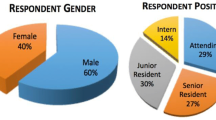Abstract
Background
Opioid misuse continues to be a major source of morbidity and mortality in the US, in both the adult and pediatric populations. Post-operative opioid prescriptions are often the first exposure children have to opioids and increases their risk of chronic use. There is significant variation in the number of opioids following identical procedures and measures have been taken within the adult population to limit this. However, specific post-operative opioid prescription guidelines are not present in the pediatric population.
Methods
Seven common pediatric surgery procedures were selected for inclusion. The recommended number of opioid doses following each procedure was determined by a multi-disciplinary expert panel. All surgery residents were sent an initial survey to determine the number of opioids they would prescribe for each procedure. They were then shown the guidelines and the survey repeated to determine changes in response.
Results
35 and 27 general surgery residents took part in and pre- and post-educational surveys respectively. In all procedures, there was a decrease in the mean number of post-operative opioids prescribed. In addition, there was an increase in the number of residents who prescribed within the guidelines and a decrease in the number who overprescribed post-operative opioids.
Conclusion
Pediatric postoperative opioid prescribing guidelines derived from expert opinion increase resident compliance with appropriate dosing; this has the potential to decrease the classic problem of general surgery residents accustomed to treating adults overprescribing opioids to children. These results are promising, and we aim to expand on this work and incorporate these guidelines into our clinical practice.
Level of evidence
III/IV.
Similar content being viewed by others
References
Hedegaard H, Miniño AM, Warner M (2018) Drug overdose deaths in the United States, 1999–2017. NCHS Data Brief 329:1–8
National Institute on Drug Abuse. Overdose Death Rates, 2019. https://www.drugabuse.gov/related-topics/trends-statistics/overdose-death-rates Accessed 11 June 2019
Kane JM, Colvin JD, Bartlett AH et al (2018) Opioid-related critical care resource use in US children’s hospitals. Pediatrics. https://doi.org/10.1542/peds.2017,3335Epub 2018 Mar 5
Harbaugh CM, Lee JS, Hu HM et al (2018) Persistent opioid use among pediatric patients after surgery. Pediatrics. https://doi.org/10.1542/peds.2017,2439Epub 2017 Dec 4
Chung CP, Callahan ST, Cooper WO et al (2018) Outpatient opioid prescriptions for children and opioid-related adverse events. Pediatrics. https://doi.org/10.1542/peds.2017Epub 2018 Jul 16
Sun EC, Darnall BD, Baker LC et al (2016) Incidence of and risk factors for chronic opioid use among opioid-naive patients in the postoperative period. JAMA Intern Med 176:1286–1293
Hill MV, McMahon ML, Stucke RS et al (2017) Wide variation and excessive dosage of opioid prescriptions for common general surgical procedures. Ann Surg 265:709–714
Makary MA, Overton HN, Wang P (2017) Overprescribing is major contributor to opioid crisis. BMJ 359:j4792
Horton JD, Munawar S, Corrigan C et al (2018) Inconsistent and excessive opioid prescribing after common pediatric surgical operations. J Pet Surg 54:1427–1431
Chen EY, Marcantonio A, Tornetta P (2018) 3rd. Correlation between 24-hour predischarge opioid use and amount of opioids prescribed at hospital discharge. JAMA Surg 153:174859
Hill MV, Stucke RS, McMahon ML et al (2018) An educational intervention decreases opioid prescribing after general surgical operations. Ann Surg 267:468–472
Overton HM, Hanna MN, Bruhn WE et al (2018) Opioid-prescribing guidelines for common surgical procedures: an expert panel consensus. J Am Colle Surg 227(4):411–418
Boulkedid R, Abdoul H, Loustau M et al (2011) Using and reporting the Delphi method for selecting healthcare quality indicators: a systematic review. PLoS ONE 6:e20476
Gaither JR, Leventhal JM, Ryan SA et al (2016) National trends in hospitalizations for opioid poisonings among children and adolescents, 1997 to 2012. JAMA Pediatr 170:1195–1201
McCabe SE, Teter CJ, Boyd CJ et al (2018) Sources of prescription medication misuse among young adults in the united states: the role of educational status. J Clin Psychiatry. https://doi.org/10.4088/jcp.17m11958
McCabe SE, West BT, Boyd CJ (2013) Leftover prescription opioids and nonmedical use among high school seniors: a multi-cohort national study. J Adolesc Health 52:480–485
Harbaugh CM, Gadepalli SK (2019) Pediatric postoperative opioid prescribing and the opioid crisis. Curr Opin Pediatr 31:378–385
Chatterjee A, Larochelle MR, Xuan Z et al (2019) Non-fatal opioid-related overdoses among adolescents in Massachusetts 2012–2014. Drug Alcohol Depend 194:28–31
Monitto CL, Hsu A, Gao S et al (2017) Opioid prescribing for the treatment of acute pain in children on hospital discharge. Anesth Analg 125:2113–2122
Author information
Authors and Affiliations
Corresponding author
Ethics declarations
Conflict of interest
The authors have no conflict of interest to declare.
Additional information
Publisher's Note
Springer Nature remains neutral with regard to jurisdictional claims in published maps and institutional affiliations.
Rights and permissions
About this article
Cite this article
Irfan, A., Martin, L.Y., Canner, J. et al. The impact of post-operative opioid guidelines on prescribing behaviors in the pediatric population. Pediatr Surg Int 36, 1339–1343 (2020). https://doi.org/10.1007/s00383-020-04739-4
Accepted:
Published:
Issue Date:
DOI: https://doi.org/10.1007/s00383-020-04739-4




